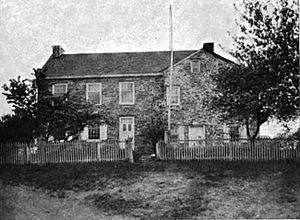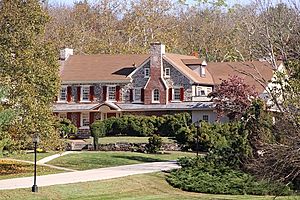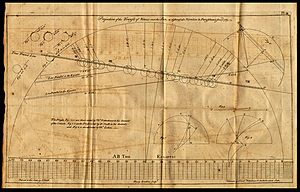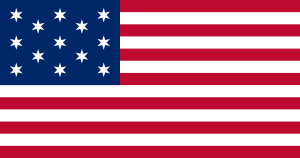David Rittenhouse facts for kids
Quick facts for kids
David Rittenhouse
|
|
|---|---|
 |
|
| Born | April 8, 1732 |
| Died | June 26, 1796 (aged 64) Philadelphia, Pennsylvania, U.S.
|
| Occupation | Astronomer Inventor Mathematician |
| Signature | |
David Rittenhouse (born April 8, 1732 – died June 26, 1796) was an amazing American who did many things. He was an astronomer (someone who studies stars and planets), an inventor, a clockmaker, a mathematician, and a surveyor. He also made scientific tools and was a public official. Rittenhouse was part of the American Philosophical Society and was the very first director of the United States Mint, which makes all the coins for the country.
Contents
Biography
David Rittenhouse was born on April 8, 1732, in a place called Roxborough Township in Philadelphia County. This area was close to a small village known as Rittenhousetown, near Germantown.
When David's uncle, William Rittenhouse, passed away, David received his uncle's carpentry tools and books. Even at a young age, David was super smart! He built a working model of his great-grandfather William Rittenhouse's paper mill. He also made other models, like a working waterwheel. David never went to elementary school. He taught himself by reading books from his family's library. He was very good at science and math. By the time David was 13, he had already mastered Isaac Newton's famous laws of motion and gravity.
Around age 17, David built a clock using wooden gears. When he was 19, he opened a shop to make scientific tools. This shop was on his father's farm in what is now East Norriton Township, Pennsylvania. Because he was so skilled with instruments, especially clocks, he built two special models of the solar system called orreries. The first one was for The College of New Jersey (which is now Princeton University). The second was for the College of Philadelphia (now the University of Pennsylvania).
His friend, Reverend William Smith, wanted David to build the second orrery for Philadelphia. He thought Philadelphia should be a major center for science. Both of these amazing orreries still exist today. One is at the University of Pennsylvania library, and the other is at Peyton Hall at Princeton University.
Clubs and Societies
Astronomers who were studying the planet Venus chose Rittenhouse to observe Venus as it passed in front of the Sun in 1769. Rittenhouse was perfect for this job because he had his own observatory at his family farm. He even made his own telescope, which was quite advanced for its time.
Rittenhouse was a member of the American Astronomical Society. This was another reason he was chosen to study Venus. Throughout his life, he was honored to be part of many different clubs and committees.
In 1768, Rittenhouse was chosen to join the American Philosophical Society. He worked as a librarian and secretary there. After Benjamin Franklin died in 1790, David became the Vice President and then the President of the society until 1796. He was also chosen as a Fellow of the American Academy of Arts and Sciences in 1782.
Another important group he joined was the Royal Society of London. It was very rare for an American to be a member of this special British society.
In 1786, Rittenhouse built a new house in Philadelphia. Next to it, he had already built an observatory shaped like an octagon. At this house, he hosted weekly meetings on Wednesday evenings. Famous people like Benjamin Franklin and Thomas Jefferson would attend these gatherings. Thomas Jefferson once wrote that he would rather go to one of these meetings than spend a whole week in Paris!
Family
David Rittenhouse was married two times. His first wife was Eleanor Coulston, whom he married on February 20, 1766. They had two daughters named Elizabeth (born in 1767) and Ester (born in 1769). Sadly, Eleanor passed away on February 23, 1771, when she was 35 years old. She died during the birth of their third baby, who also did not survive.
David married his second wife, Hannah Jacobs, in late 1772. They had a baby who died at birth in late 1773. Hannah lived longer than David, passing away in late 1799.
David's grandson, who was Ester's son, was named David Rittenhouse Waters.
Important Contributions to the United States
David Rittenhouse made many important discoveries and contributions to the United States. Early in his career, he worked as a surveyor for Great Britain. Later, he worked for the Pennsylvania government. From 1763 to 1764, he surveyed the border between Delaware and Pennsylvania. His work was so exact that it was used without any changes by Charles Mason and Jeremiah Dixon for their famous survey of the Pennsylvania–Maryland border.
Later, Rittenhouse helped set the borders for other states, both before and after America became independent. This included the borders between New Jersey, New York, and Pennsylvania. In 1784, Rittenhouse and Andrew Ellicott finished the survey of the Mason–Dixon line. When his surveying work ended, he went back to his scientific interests.
Transit of Venus
In 1768, the same year he joined the American Philosophical Society, Rittenhouse announced plans to watch a rare event: Venus passing directly in front of the Sun. The American Philosophical Society helped get money to buy new telescopes. Many members volunteered to help observe this special event.
The transit of Venus happened on June 3, 1769. Rittenhouse was so excited about watching this rare event, which he had prepared for a whole year, that he actually fainted during the observation! He had also been sick the week before. He was lying on his back under the telescope, looking at the afternoon sun. After a few minutes, he woke up and kept observing. His detailed report about the transit, published later, didn't mention his fainting.
Rittenhouse used his observations to figure out the distance from Earth to the Sun. He calculated it to be 93 million miles. This is very close to the actual average distance! European scientists praised his report, and Rittenhouse corresponded with famous astronomers of his time.
Orrery
In 1770, Rittenhouse finished building a very advanced orrery. This was a mechanical model that showed how the planets move around the Sun. Because of this amazing achievement, the College of New Jersey gave Rittenhouse an honorary degree. The college then bought the orrery.
Rittenhouse then made a new, even more advanced model that stayed in Philadelphia. The State of Pennsylvania paid Rittenhouse £300 as a reward for his great work. One of Rittenhouse's helpers on this project was Henry Voigt, a clockmaker. Voigt later became the Chief Coiner under Rittenhouse at the mint.
United States Mint
David Rittenhouse was the treasurer of Pennsylvania from 1777 to 1789. With these skills and the help of George Washington, he became the first director of the United States Mint. The United States Mint opened on April 2, 1792. However, it didn't make coins for almost four months. Rittenhouse believed that the design of a coin showed how smart and cultured a country was.
The very first coins were made from flatware that George Washington himself provided on July 30, 1792. Rittenhouse struck these coins by hand to test the new equipment. He gave them to Washington as a thank-you for helping make the Mint a reality. Large-scale coin production didn't start until 1793. Rittenhouse resigned from the Mint on June 30, 1795, because he was not in good health. In 1871, Congress approved a special medal to honor him.
Other Contributions
In 1781, Rittenhouse became the first American to see the planet Uranus.
In 1785, Rittenhouse made what might have been the first diffraction grating. This was a tool made with 50 hairs placed between two finely threaded screws. It had about 100 lines per inch. This was similar to a technique that Joseph von Fraunhofer used much later in 1821.
Notable Events

Here are some other important events in David Rittenhouse's life:
- 1763–1764 Worked on surveying the border between Pennsylvania and Maryland.
- 1767 Received an honorary master's degree from the College of Philadelphia (now University of Pennsylvania).
- 1768 Discovered that Venus has an atmosphere.
- 1769 Observed the transit of Venus.
- 1770 Moved to Philadelphia.
- 1775 Became an Engineer for the Committee of Safety.
- 1779–1782 Was a Professor of Astronomy at the University of the State of Pennsylvania (now the University of Pennsylvania).
- 1780–1782 Served as Vice-provost.
- 1782–1796 Was a Trustee.
- 1779–1787 Served as Treasurer of Pennsylvania.
- 1784 Finished the survey of the Mason–Dixon line.
- 1791–1796 Was President of the American Philosophical Society.
- 1792–1795 Was the first Director of the United States Mint.
- 1793 Helped start the Democratic-Republican Societies in Philadelphia.
Tributes to David Rittenhouse
- The Rittenhouse Crater on the Moon is named after David Rittenhouse.
- Rittenhouse Square is one of the main parks in the center of Philadelphia. It was one of the original squares planned by William Penn. In 1825, it was renamed in David Rittenhouse's honor.
- To the west of Rittenhouse Square, on Walnut Street, the University of Pennsylvania has its Physics and Mathematics departments in the David Rittenhouse Laboratory.
- One of Rittenhouse's friends, Francis Hopkinson, helped write the Flag Act of 1777. This act described the flag of the United States of America. It said the blue field of stars represented "a new constellation." Some people think this was a direct tribute to Rittenhouse, because he was an astronomer.
- David Rittenhouse Junior High School in Norristown, Pennsylvania is named after him.
- Rittenhouse's nephew, William Barton, wrote a book about his life called Memoirs of the life of David Rittenhouse.
See also
 In Spanish: David Rittenhouse para niños
In Spanish: David Rittenhouse para niños





